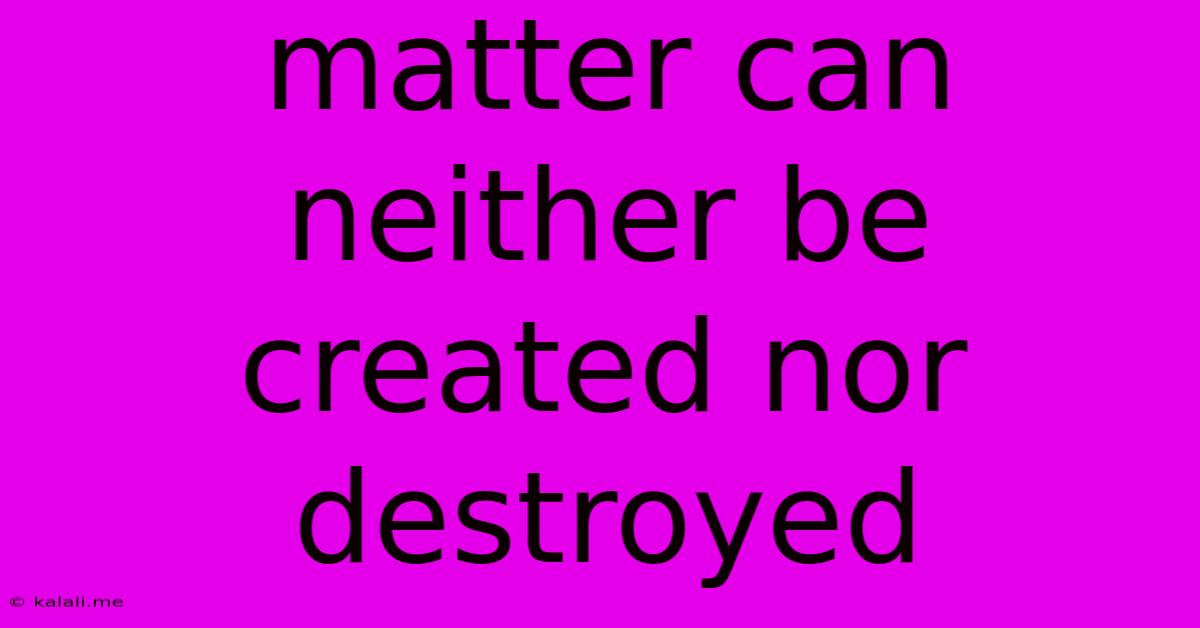Matter Can Neither Be Created Nor Destroyed
Kalali
May 20, 2025 · 3 min read

Table of Contents
The Unbreakable Law: Matter Can Neither Be Created Nor Destroyed
The principle of conservation of mass, often simplified to "matter can neither be created nor destroyed," is a cornerstone of modern science. This fundamental law, a pillar of chemistry and physics, states that the total amount of matter in a closed system remains constant over time. While it might seem intuitive, understanding its nuances and implications reveals a profound truth about the universe. This article delves into this crucial concept, exploring its history, applications, and the subtle complexities that surround it.
A Brief History and Early Misconceptions
The concept's origins are rooted in ancient philosophical debates about the nature of reality. However, the scientific formulation of the law is largely attributed to Antoine Lavoisier, a French chemist in the late 18th century. Lavoisier's meticulous experiments, particularly those involving combustion, showed that while substances might transform – wood burning into ash and gases, for instance – the total mass remained unchanged. This observation laid the groundwork for the law of conservation of mass. Early interpretations were relatively straightforward, focusing on the observable transformations of matter.
Understanding the Nuances: Open and Closed Systems
It’s crucial to understand that the law applies primarily to closed systems: systems where no matter enters or leaves. Think of a sealed container undergoing a chemical reaction. The total mass within that container will remain constant, regardless of the changes occurring within. However, in open systems, where matter can be exchanged with the surroundings, the law doesn't directly apply in the same way. For example, a burning candle loses mass as it consumes oxygen and produces carbon dioxide and water vapor. The total mass is conserved if we consider the entire system—including the surrounding air.
The Atomic Perspective: A Deeper Look
At the atomic level, the law takes on an even richer meaning. Chemical reactions involve the rearrangement of atoms, not the creation or destruction of them. In a reaction, atoms are bonded and re-bonded, forming new molecules with different properties, but the number of each type of atom remains unchanged. This perspective highlights the fundamental stability of matter at its most basic level. Understanding this atomic rearrangement is key to comprehending chemical stoichiometry and balancing chemical equations.
Relativity and Mass-Energy Equivalence: A Modern Twist
Einstein's theory of relativity introduced a significant refinement to the law. E=mc², the famous mass-energy equivalence equation, shows that mass and energy are interchangeable. While matter cannot be created or destroyed in isolation, it can be converted into energy, and vice versa. Nuclear reactions, such as fission and fusion, exemplify this. In these processes, a small amount of mass is converted into a tremendous amount of energy, demonstrating the interconnectedness of mass and energy. However, even in these transformations, the total mass-energy remains constant within a closed system.
Applications and Importance
The law of conservation of mass has profound implications across numerous scientific disciplines:
- Chemistry: It underpins stoichiometry, allowing accurate predictions of reaction yields and compositions.
- Engineering: It's essential for designing and optimizing chemical processes and reactions.
- Environmental science: It's crucial for understanding the cycling of matter in ecosystems and the impact of pollution.
- Physics: It forms the basis of many fundamental physical laws and models.
The law of conservation of mass is more than just a scientific principle; it's a fundamental truth about the universe. While the relationship between mass and energy adds a layer of complexity, the underlying principle remains: the total amount of matter and energy in a closed system remains constant, providing a robust and essential framework for understanding the physical world.
Latest Posts
Latest Posts
-
Reasons Not To Join A Union Uk
May 20, 2025
-
Difference Between A Spade And A Shovel
May 20, 2025
-
How To Remove Plaster From Brick Wall
May 20, 2025
-
Wiring A Three Way Light Switch Uk
May 20, 2025
-
Other Ways To Say I Have
May 20, 2025
Related Post
Thank you for visiting our website which covers about Matter Can Neither Be Created Nor Destroyed . We hope the information provided has been useful to you. Feel free to contact us if you have any questions or need further assistance. See you next time and don't miss to bookmark.